If you think email automation is just about saving the redundancy of manual sending, you are missing out. It’s much more than that!
Let’s not take away other credits of email automation, such as personalization, increased engagement, scalability, higher conversion rates, and cost-effectiveness.
This blog discusses the ins and outs of email automation, its benefits, step-by-step instructions for automating email campaigns, automated email examples, and the top email marketing automation tools available.
Send automated emails the easiest way with Retainful to increase conversions and engagement.
What is Email Automation?
Email automation is the process of sending emails at a scheduled time to targeted audiences with the help of marketing automation tools.
Sending automated emails involves setting up automated email workflows that include triggers. Automated emails are sent based on these triggers, which are basically predefined conditions or criteria.
For e.g., you can send automated welcome email series when the customer signs up to reach the customer almost immediately after they sign up.
Email marketing automation allows you to reach the right customers at the right time, effectively engaging the audience, nurturing leads, and driving sales while saving you time and effort.
Benefits of Email Automation
Yes, email automation does hold great potential and power to improve your business. Let’s drop the generalization and get to the specifics.
Saves time
When you automate your emails, you set a trigger condition, which automatically sends the email based on the user’s action.
You just have to set conditions once and update them periodically. This automation workflow takes care of sending to the right recipient at the right time.
Personalized customer experience
Yes, using the customer’s name in the subject line does count as email personalization, but you could go deeper than that with automated emailing.
Advanced segmentation lets you group customers with the same purchase behavior for more targeted emails. This allows you to send personalized product recommendations, exclusive offers, early access deals, and loyalty programs.
Engages and re-engages customer
Since automated emails reach the customers at the right time based on their purchase behavior or purchase history, it keeps your customers engaged.
In case your customers have not returned to the store in a long time, you can always check in on them using a follow-up email or a win-back email with a next-order coupon that will definitely re-engage them and tempt them to make a purchase.
No risk of human errors
Automated emails reach the right people at the right time with the right information. This eliminates the risk of human error in remembering to send emails on time.
Also, the email automation feature comes with pre-built templates for various emails. When using these templates, it ensures that the content is standardized and reduces the chances of errors in the message.
How to automate emails using an email automation tool?
Let’s say the benefits of automation have persuaded you to choose automated email sending. Automated emailing usually has just 5 common steps. This section will walk you through those steps.
Step 1 – Install and Integrate: When you have found the best email automation software, install it and integrate it with your eCommerce store. The trick is to find a tool that aligns with your business goals and is user-friendly right from the installation process. The integration must be seamless to safely update your data into the automation tool.
Step 2 – Create an email list: If you already have an email list, skip to the next step. In case you are new to email marketing automation, use sign-up forms and double opt-ins to create an email list.
Step 3 – Segment your email list: Segment your email list based on customer’s purchase behavior. This keeps your emails more targeted and relevant, which in turn, will increase your engagement rate.
Step 4 – Template setup: You can customize the template with your business’s different design elements to increase relevance and brand authority. Always ensure there’s a CTA.
Step 5 – Automation workflow: Workflows usually have trigger and wait conditions. The trigger is a preset condition that when customers fulfill, they enter the workflow and an automated email is sent to them. Wait conditions are set to delay the email being sent immediately. For example, you want to send a welcome email almost immediately, whereas a product review email 24 hours after the delivery of the product.
5 Best Email Automation tools
There are many email automation tools available. It can be very confusing, and there is a high chance that you will choose the wrong one. So, we have a list of all the top email automation tools to make it easier for you.
1. Retainful
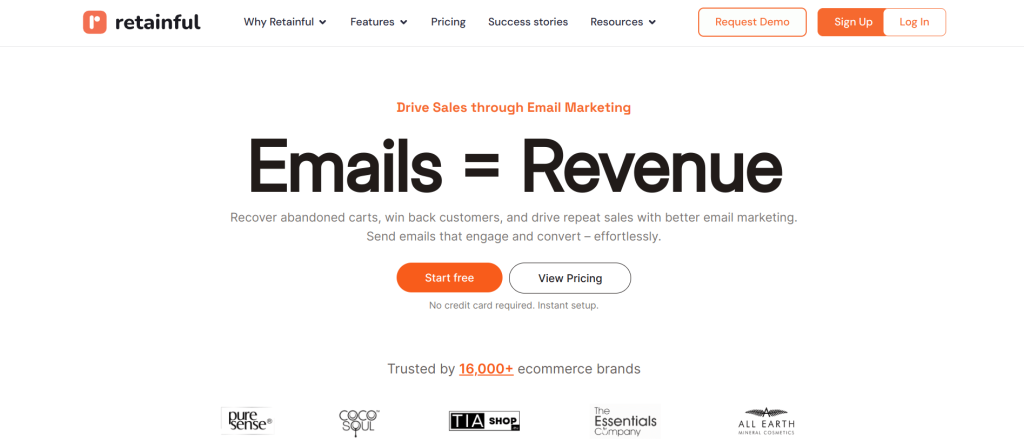
Retainful is the best email automation tool because it simplifies customer engagement and retention through its user-friendly automation workflows. This allows businesses to effortlessly set up personalized marketing campaigns.
With customizable templates and segmentation capabilities, businesses can tailor their messages to specific customer segments, maximizing relevance and effectiveness. Integration and installation are seamless, ensuring smooth implementation across platforms.
Retainful’s automation triggers enable businesses to respond promptly to various customer actions, such as sending welcome emails upon sign-up and abandoned cart reminders to re-engage customers. This enhances customer experience and drives sales.
Key Features
- Seamless integration
- Easy automation workflows
- Customizable pre-built templates
- Email segmentation
- Sign-up forms and popups
- Welcome emails
- Thank you emails
- Abandoned cart emails
- Win back emails
- Order follow-up emails
- Next order coupons
- Analytics and Reporting
Set up automation workflow & customize the templates in a few clicks with Retainful to increase conversions.
2. Omnisend
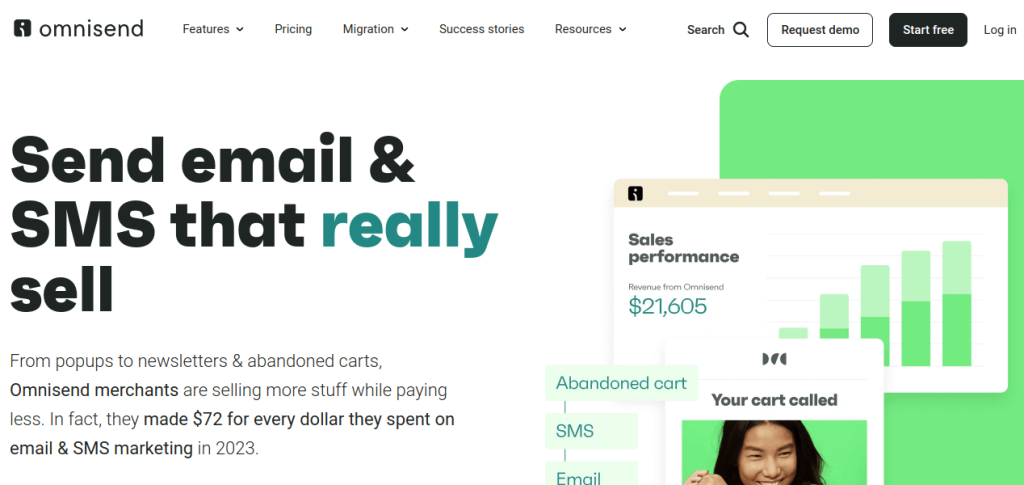
Omnisend offers features tailored to streamline email marketing automation efforts. With its intuitive drag-and-drop email editor, creating email campaigns becomes effortless.
Businesses can automate their email workflows, ensuring timely communication with customers throughout their journey. Omnisend’s reporting capabilities provide valuable insights into campaign performance, allowing businesses to refine their strategies.
3. Hubspot
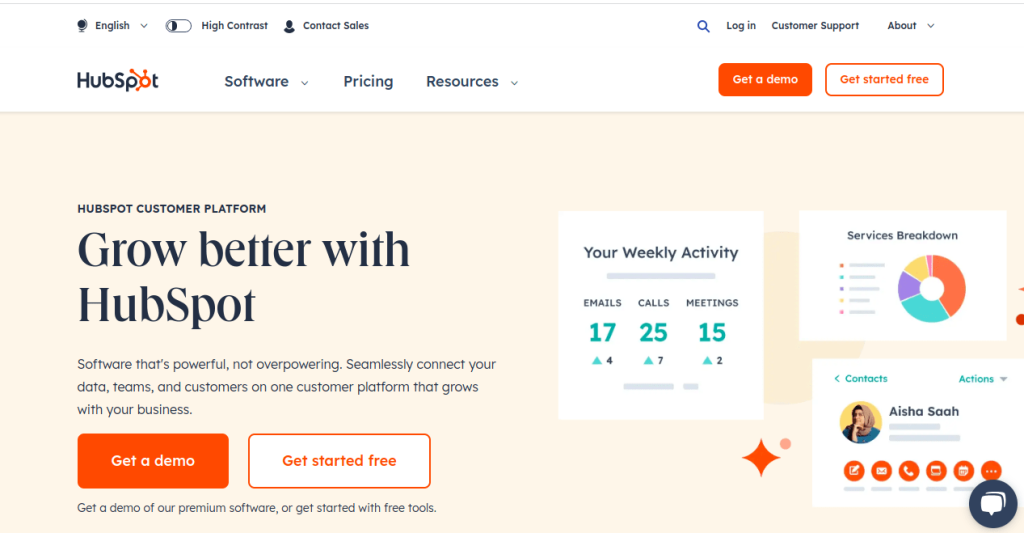
HubSpot’s automated email campaigns streamline communication, enabling businesses to effortlessly reach their audience with timely messages. With targeted email campaigns, businesses can ensure messages resonate with each recipient.
HubSpot’s email triggers allow for automated responses to specific customer actions, enhancing efficiency and effectiveness. Additionally, its chatbots provide instant support and interaction.
4. Mailchimp
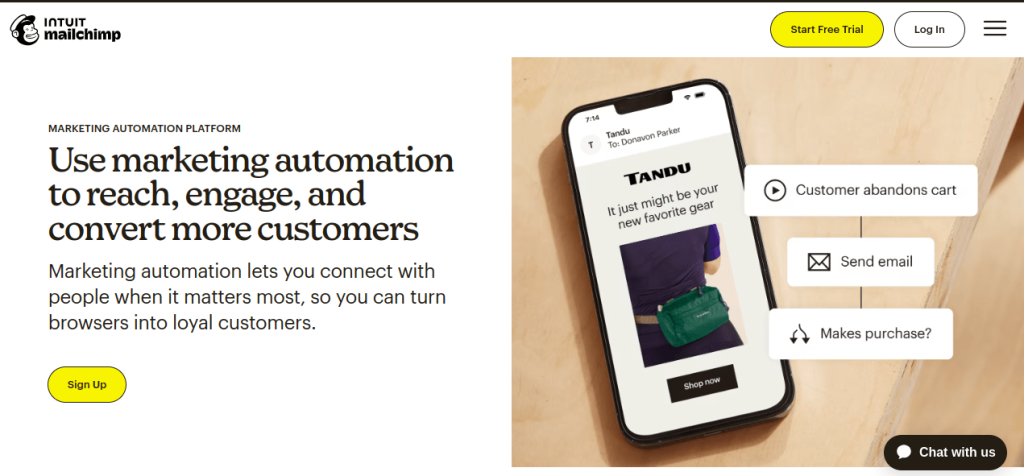
Mailchimp comes with pre-set automations that simplify the automation process, allowing users to quickly implement effective campaigns. Mailchimp’s segmentation tools enable precise targeting, ensuring messages resonate with specific customer groups.
Trigger-based emails automatically respond to customer actions for timely engagement. With comprehensive analytics, businesses can track campaign performance and gain valuable insights to refine their strategies.
Related Reading: Explore the best Mailchimp alternatives in our comparison blog: 8 Best Mailchimp Alternatives in 2024
5. Constant Contact
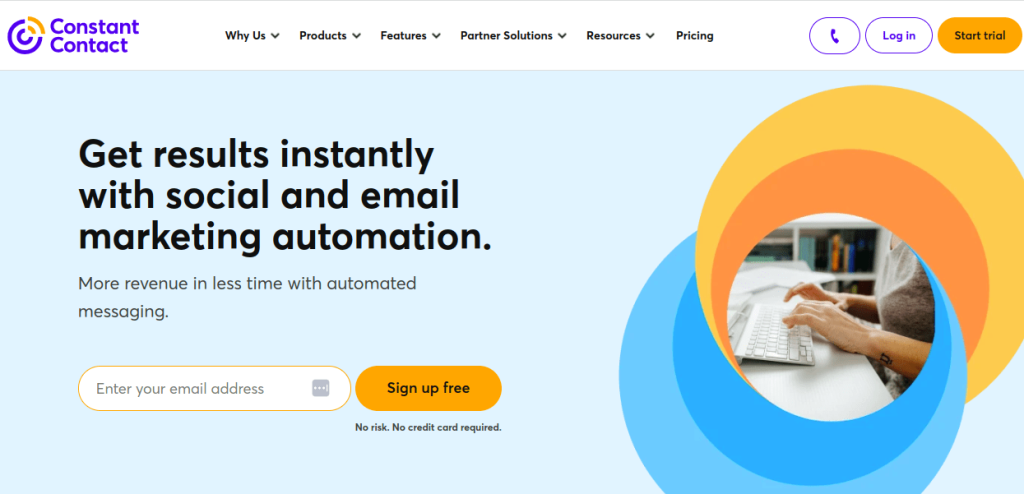
Constant Contact offers an email automation feature so businesses can streamline their communication efforts. You can also build and manage email lists to maximize engagement.
The intuitive drag-and-drop editing interface allows for customization of email content, while editable templates provide professional-looking campaigns. Also, you can track results in real time to gauge the effectiveness of campaigns.
Examples of Email Automation
As an eCommerce business owner, you have to automate emails for every step of the customer’s journey. This section will show you the necessary email marketing automations every eCommerce owner should not skip.
Welcome emails
The first automated email your customers expect to receive when they sign up for your brand and your newsletters are welcome emails.
Since it is a confirmation email, welcome email automation has very high open rates. You can even include a welcome discount or a next-order coupon followed by a CTA to increase conversions.
Trigger: When the customer signs up or makes the first purchase.
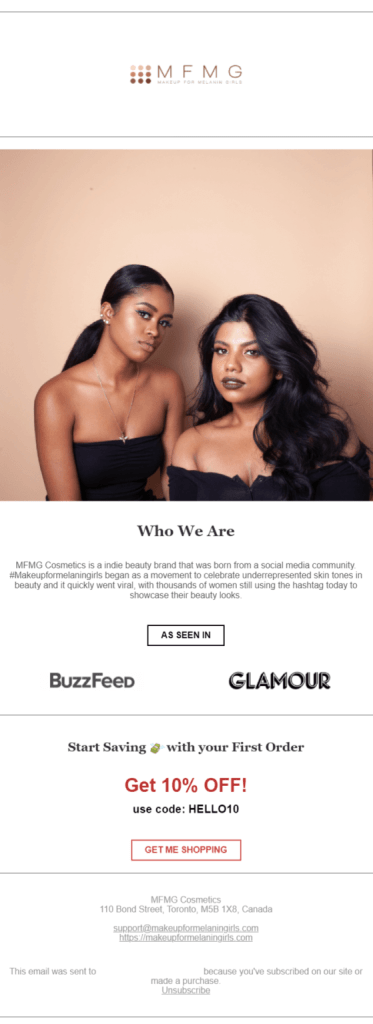
It’s a good welcome email with a succinct brand story, followed by a welcome discount and a CTA. If you have an email marketing automation tool like Retainful that can also help you include discount codes, it will make things so much easier for you.
Related Reading: Discover the best welcome email examples & templates and get inspired to create your own.
Order confirmation emails
If your customers don’t receive an almost immediate order confirmation email, your brand will lose its credibility. These automated emails are supposed to relieve the customers of their online purchase anxiety.
Typically these emails have the order details such as the product details, order number, amount paid, and shipping or billing address. You can always go a step further to show product recommendations.
Trigger: when a customer places an order.
Here is an example of an automated order follow-up email template.
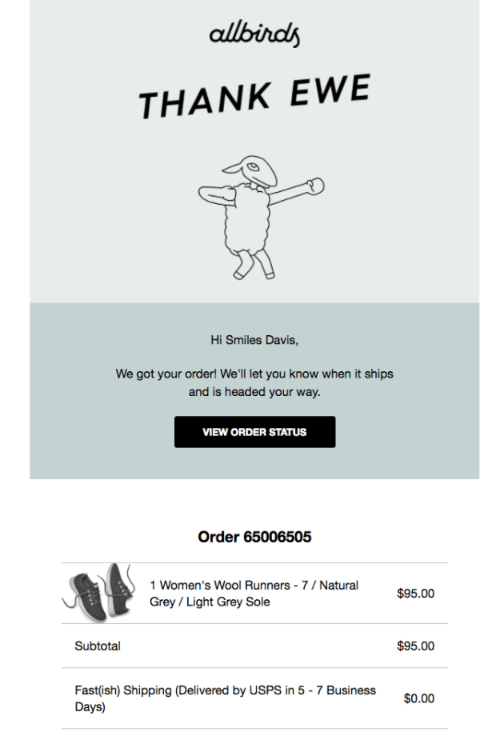
This AllBirds order confirmation email is simple and conveys everything necessary, including the ordered products, order number, subtotal, shipping details, and a CTA to view the order status.
Abandoned cart emails
Sometimes customers browse and add products to the cart but then just leave the online store without finishing the purchase. You can always send them an abandoned cart email to remind them of the products they left in the cart.
Just include the products that they have left in the cart, a discount or free shipping, and maybe even some product recommendations. Also, you can turn this into an abandoned cart email series in case the customers have not returned to finish the purchase with the very first email you sent.
Trigger: When a customer abandons the cart for more than 24 hours.
You can also customize the trigger to send an abandoned cart email if the cart is unattended for more than an hour or two. Just be cautious not to overwhelm customers with too many pushy emails.
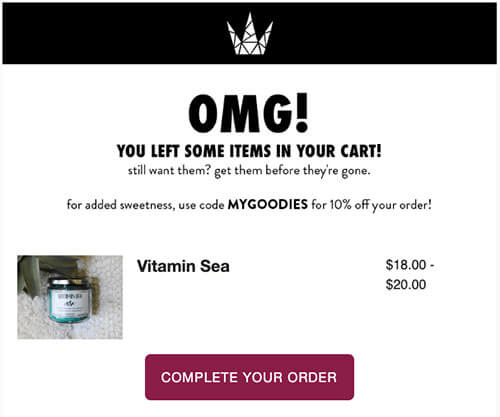
This automated email example is effective because it includes an image of the product, its price, a discount code, and a CTA for immediate action.
Thank you emails
If you want your customers to feel appreciated and return for repeated purchases, send them thank-you emails. These automated emails usually include a thank-you note, a next-order coupon, and sometimes product recommendations or review requests.
Trigger: When a customer finishes a purchase or receives their order.
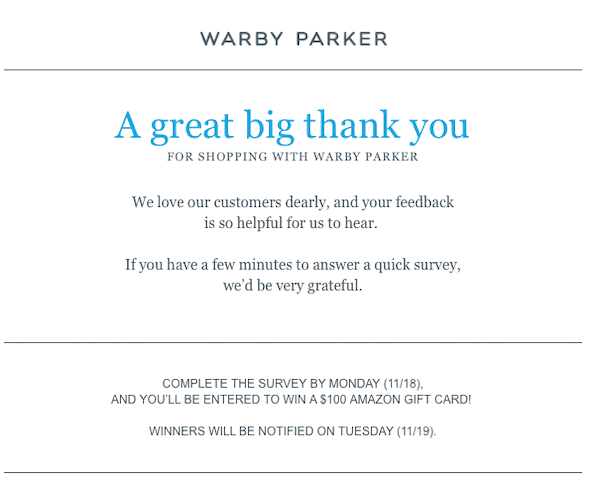
Warby Parker’s automated email example here includes a thank you note, a request for feedback, and a very strategic gift card that the customer will receive if they submit feedback.
Related Reading: Take a look at these thank you email templates and get creative in showing gratitude to your customers.
Winback emails
If your customer has not returned to your shop in a while, you can check in on them using winback emails. Include the new products or any new improvements you have made to your brand. You can also include a next-order coupon or a discount code to catch their attention.
Trigger: When a customer hasn’t shopped in 60 days.
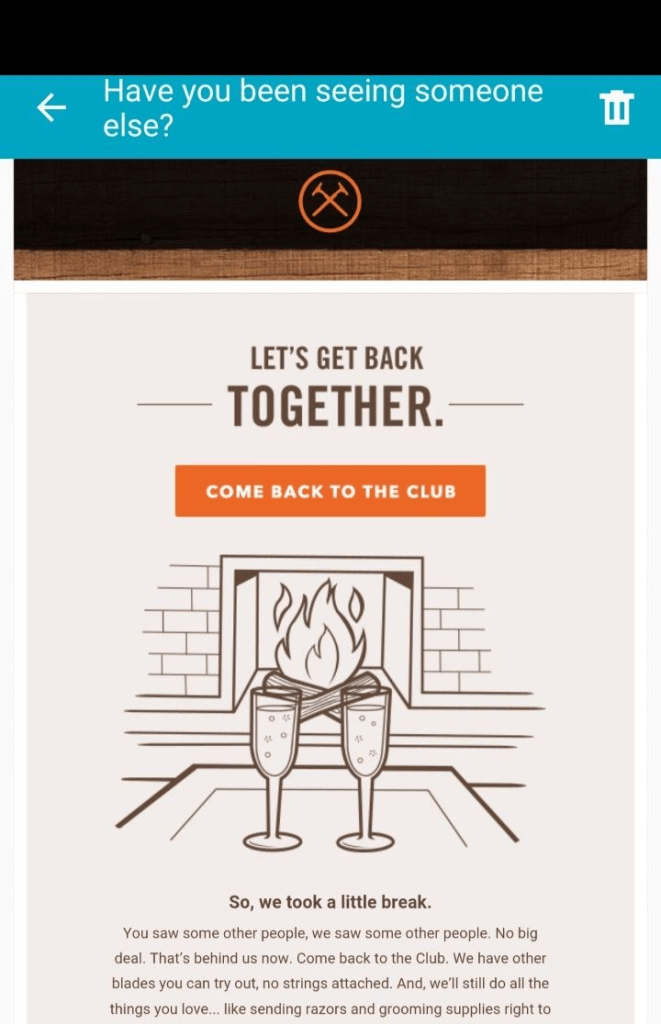
Dollar Shave Club’s automated email example here has a CTA at the very beginning asking customers to come back. There’s nothing fancy about this automated email, but it has a funny copy that easily catches attention which is very necessary for a customer who has not been to your online store in a while.
Launch your automated email campaigns easily with Retainful and drive uninterrupted sales.
Ready to Automate your Emails?
See how easy that was? All you have to do is set your brand’s goals and find out what types of email automations you need. Then, find an email marketing automation tool that will let you automate, customize, and add elements like dynamic coupons.
Automate your emails today and maintain consistency and you’ll start seeing an upward curve in your engagement and conversion rate gradually.
Read next:
- 18 Effective Email Marketing Strategies for 2024
- 11 Email Automation Best Practices to Send Tailored Email Campaigns
- WooCommerce Email Marketing: An Ultimate Beginner’s Guide
- Shopify Marketing Automation: A Complete Guide (+Apps)
Automation in email refers to the process of setting up predefined actions or responses to occur automatically based on certain triggers or conditions within an email system.
You can create an automated email by using email marketing software or platforms like Retainful that offer features like triggers, and personalized messaging to set up automated responses based on subscriber behavior or specified schedules.
To plan email automation effectively, start by identifying your goals, segmenting your audience, mapping out the customer journey, creating engaging content, setting up triggers, and continuously optimizing based on performance metrics.
The key benefit of using email automation is the ability to streamline communication, increase efficiency, and deliver personalized messages, leading to improved engagement, higher conversion rates, and enhanced customer satisfaction.
Install Retainful. Go to Retainful Dashboard -> Automations -> click on the type of email automation you want -> set up triggers and wait condition -> customize the template -> save and start the workflow.
